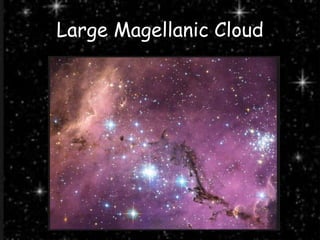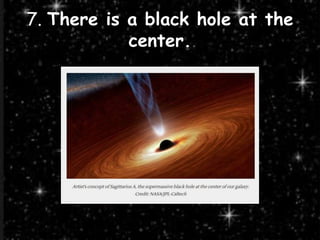Ch 20 -galaxies
- 1. Galaxies far far away. We see clusters of stars. These make a galaxy. Then we see clusters of galaxies and clusters of clusters of galaxies. And clusters of clusters of clusters of clusters of galaxies.
- 2. What is a Galaxy? • a system of millions or billions of stars, together with gas and dust, held together by gravitational attraction.
- 3. Classification System • Elliptical: • 1. Elliptical galaxies are shaped like a spheriod, or elongated sphere. In the sky, where we can only see two of their three dimensions, these galaxies look like elliptical, or oval, shaped disks. • a. The light is smooth, with the surface brightness decreasing as you go farther out from the center. • b. Elliptical galaxies are given a classification that corresponds to their elongation from a perfect circle, otherwise known as their ellipticity. • 1. The larger the number, the more elliptical the galaxy. So, for example a galaxy of classification of E0 appears to be perfectly circular, while a classification of E7 is very flattened. The elliptical scale varies from E0 to E7.
- 5. Spiral • 1. Spiral galaxies have three main components: a bulge, disk, and halo. • a. The bulge is a spherical structure found in the center of the galaxy. This feature mostly contains older stars. • b. The disk is made up of dust, gas, and younger stars. The disk forms arm structures. Our Sun is located in an arm of our galaxy, the Milky Way. • c. The halo of a galaxy is a loose, spherical structure located around the bulge and some of the disk. The halo contains old clusters of stars, known as globular clusters.
- 6. Spiral • 1. Spiral galaxies are classified into two groups, ordinary and barred. • a. The ordinary group is designated by S or SA. • 1. In ordinary spirals the arms originate directly from the nucleus, or bulge. • b. The barred group is designated by SB. 1. In the barred spirals there is a bar of material that runs through the nucleus that the arms emerge from. • 2. Both of these types are given a classification according to how tightly their arms are wound. • The classifications are a, b, c, d ... with "a" having the tightest arms. • In type "a", the arms are usually not well defined and form almost a circular pattern. Sometimes you will see the classification of a galaxy with two lower case letters. This means that the tightness of the spiral structure is halfway between those two letters.
- 8. S0 (zero) Galaxies • S0 galaxies are an intermediate type of galaxy between E7 and a "true" spiral Sa. They differ from ellipticals because they have a bulge and a thin disk, but are different from Sa because they have no spiral structure. S0 galaxies are also known as Lenticular galaxies.
- 9. Lenticular Galaxy But despite the fact that it does have a central bulge similar to that of Spiral galaxies, it is much larger, on average, than traditional Spirals.
- 10. More on Lenticular Galaxies • In terms of content - such as stars and gas content – Lenticular galaxies have the most in common with Elliptical galaxies. • 1. They have mostly old, red stars with very few hot blue stars. This is an indication that star formation has slowed significantly, or is non-existant. • 2. Lenticular and Elliptical galaxies both have a distinct lack of interstellar gas, a key component for continued star formation. • But: unlike Ellipticals, the Lenticular galaxies still contain a significant amount of interstellar dust.
- 11. Irregular Galaxies • Irregular galaxies have no particular shape. They are among the smallest galaxies and are full of gas and dust. Having a lot of gas and dust means that these galaxies have a lot of star formation going on within them. This can make them very bright. The Large and Small Magellanic Clouds are examples of irregular galaxies. They are two small galaxies which orbit around our own Milky Way Galaxy. About 20% of all galaxies are irregulars.
- 12. The Hubble Classification System • Spiral Galaxies • As their name implies, spiral galaxies have outstretched, curving arms suggestive of a whirlpool or pinwheel. Hubble distinguished different sub-classes according to the tightness of the arms and the size of the nucleus. He called these Sa, Sb, and Sc. In terms of the arms, Sa is the tightest wound while Sc is the most open. In terms of the nucleus, Sa has the largest while Sc has the smallest. The galaxies that appear to have a spiral disc but no visible arms are called S0. • Barred Spirals • Barred spirals show the same spiral structure as normal spirals, and also a prominent bar through the nucleus. The spiral arms emerge from the end of the bar. The sub- classifications are the same as for normal spirals. • Irregulars • Certain galaxies lack either an obvious spiral structure or nuclear bulge, appearing instead as a random collection of stars with no obvious order. They are distinguished from ellipticals by their lack of symmetry. • Elliptical Galaxies An elliptical galaxy shows no spiral structure and can vary from almost round (what Hubble called E0) to almost cigar shaped (called E7). This classification is based on our perspective from Earth and not on the actual shape.
- 15. Fill in the table.
- 16. The Milky Way The Milky Way Galaxy is an immense and very interesting place. Not only does it measure some 100,000–120,000 light-years in diameter, it is home to planet Earth, the birthplace of humanity. Our Solar System resides roughly 27,000 light- years away from the Galactic Center, on the inner edge of one of the spiral-shaped concentrations of gas and dust particles called the Orion Arm.
- 17. The Milky Way is Warped • For starters, the Milky Way is a disk about 120,000 light years across with a central bulge that has a diameter of 12,000 light years. The disk is far from perfectly flat though, as can be seen in the picture below.
- 18. LMC and SMC • It is warped in shape, a fact which astronomers attribute to the our galaxy’s two neighbors -the Large and Small Magellanic clouds. • These two dwarf galaxies — which are part of our “Local Group” of galaxies and may be orbiting the Milky Way — are believed to have been pulling on the dark matter in our galaxy like in a game of galactic tug-of-war. The tugging creates a sort of oscillating frequency that pulls on the galaxy’s hydrogen gas, of which the Milky Way has a great deal.
- 19. LMC and SMC • The Large Magellanic Cloud lies about 163 thousand light-years from Earth. Its companion, the Small Magellanic Cloud is about 200,000 light-years away. • For many years astronomers thought the Magellanic Clouds orbited the Milky Way. Recent measurements may prove that they could be moving too fast for that. • The Magellanic Clouds are gas-rich, meaning they have a higher portion of their mass as gas. They also have less portion of their mass bound up in metallic elements. • The Magellanic Clouds have both had their shapes distorted by gravitational interactions with the Milky Way. As these galaxies pass near the Milky Way, their gravitational pull also misshapes the outer bars of our galaxy.
- 21. LMC • The Large Magellanic Cloud contains a highly active starbirth region called the Tarantula Nebula. It is part of a larger cloud of gas and dust, and its high rate of star formation may be caused by compression of interstellar gas and dust by the collision of the cloud with the interstellar medium. The 1987a supernova exploded not far from this region.
- 23. SMC • Recent studies of the Small Magellanic Cloud indicate that it might be a former single galaxy split into two remnants. Gravitational interactions with the LMC may have broken that galaxy apart.
- 24. 1. The Milky Way is warped. 2. It has a halo, but you can’t directly see it. • 3. It has over 200 billion stars • 4. Its really dusty and gassy. • 5. It was made from other galaxies. • 6. Every picture you’ve seen of the Milky Way from above is either another galaxy or an artist’s interpretation.
- 25. 7. There is a black hole at the center.
- 26. • 8. It’s almost as old as the Universe itself. • 9. It’s part of the Virgo Supercluster, a group of galaxies within 150 million light years. • 10. It’s on the move.

























